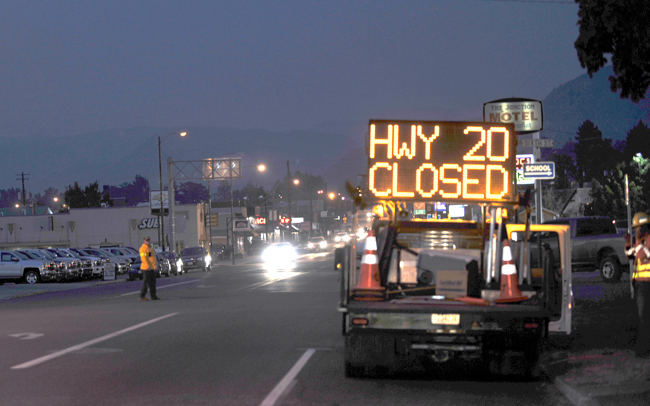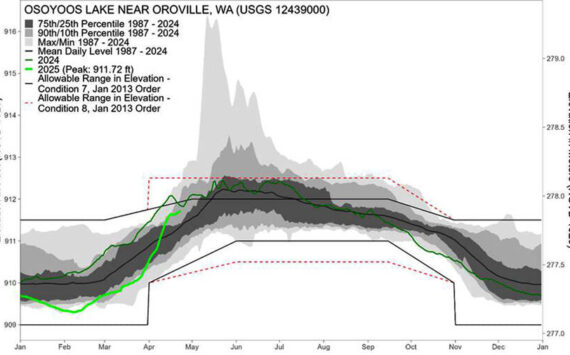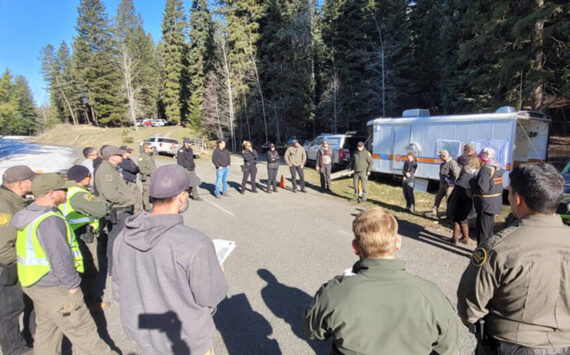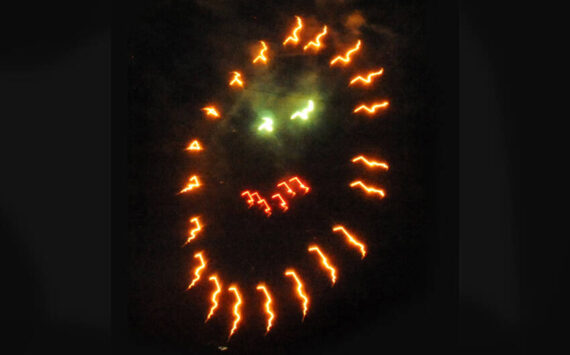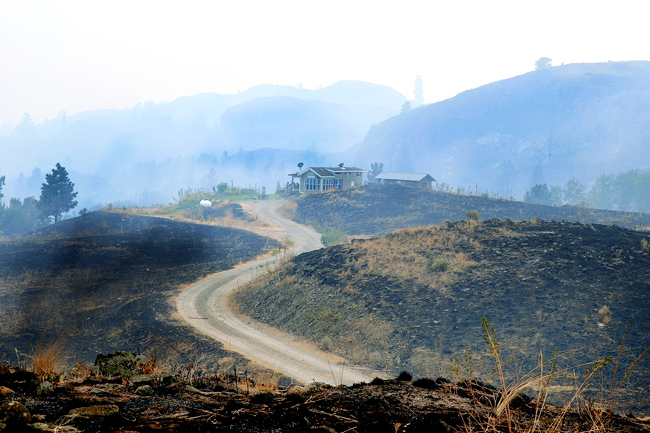
Okanogan Complex burns 285,399 acres
I’d rather have people alive to gripe than dead because we didn’t evacuate.” Patrick Plumb, Tonasket Mayor
OKANOGAN COUNTY – The Okanogan Complex Fire has grown to be the largest wildfire in Washington State History, even surpassing last year’s devastating record breaking fires in the Methow and Pateros areas known as the Carlton Complex.
The Okanogan Complex which includes fires in the Lime Belt, Blue Lake, Tunk Block, Beaver Lake and Nine Mile areas in Okanogan County, encompasses some 258,399 acres, more than 400 square miles, and is being said to be only 10 percent contained, according to the Northeast Washington Fire Update. Fire officials say more than 1200 people are battling the fire which has threatened as many as 5000 homes. Among the crews battling the fire are US Forest and DNR firefighters, 200 Washington State National Guardsmen, local fire departments, fire departments from all over the state and citizen volunteers. Sixteen of the firefighters from Australia who came to battle the fires raging across the Western United States have joined the fight against the Okanogan Complex Fires as well. Unfortunately, the fires could burn for several more months, according to Fire spokesman Rick Isaacson.
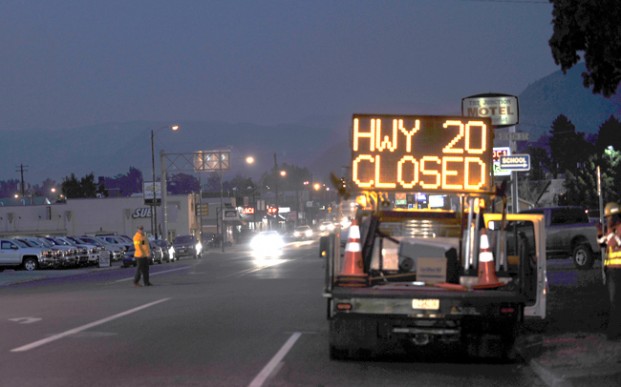
Since the first of the fires, Nine Mile, started on Thursday, Aug. 13, there have been several evacuations declared, including of the towns of Tonasket, Conconully, Twisp and in the Aeneas Valley, Pine Creek and Tunk areas. Currently the Level 3 evacuation, which was declared on Thursday, Aug. 20 in Tonasket, has dropped to a Level 1, according to Tonasket Mayor Patrick Plumb, who has been keeping his town updated through the Facebook page, Tonasket, Washington, Stuff You Should Know.
“There’s been some grumbling about the Level 3 evacuation of town, but I’ve talked to the DNR and many of them said the fire outside of Tonasket was acting in a way they’d never seen before,” said Mayor Plumb. “When you get firefighters with this kind of experience and the reports they were getting, you understand why the call was made.
“The EOC was prudent… I’d rather have people alive to gripe than dead because we didn’t evacuate. We lost no homes in Tonasket, but the numbers lost elsewhere, if you heard them they’d make you cry. I believe this is going to be much worse than the Carlton in terms of homes lost.”
Plumb added, “I think the Tonasket firefighters and heavy equipment operators who did the back burn a couple of days ago eliminated the danger to our town.”
The mayor went on to applaud the efforts of the firefighters, both on hand lines and local citizen volunteers, as well as all those that have been helping with those that had to evacuate from the areas around Tonasket, as well as local businesses in Tonasket, Loomis and Oroville who have opened their doors to help the community. He wasn’t so charitable with the traditional national aid organizations.
“Our local people, some of them put their health on the line driving through smoke to lend a hand to people who lost homes. The national organizations have done little to help, but the locals have really come through,” Plumb said.
As of Tuesday, Stage 3 evacuations are still in effect for all of Aeneas Valley.The area northeast of Nespelem is still under Level 3 evacuations with the addition of South Nanamkin Creek north to the…
A Level 1 evacuation order is an alert to people about the potential danger and evacuations are voluntarry, Level 2 means to get ready and evacuate to friends or a shelter outside the fire danger area; those choosing to stay should be ready to leave at a moments notice and Level 3 means to leave immediately.
Suppression efforts in the Okanogan Complex made good progress Monday even though heavy smoke impaired visibility and air support was unable to operate. While the high level inversion kept fire activity somewhat subdued there were many areas of high fire activity.
Tunk Block Fire: The fire was active on the north end where work was done on an indirect line along the northwest side. On the northeast side efforts were successful in keeping the fire out of the Aeneas Valley. A spot fire along the Omak Lookout Road was successfully lined; crews patrolled the road throughout the day. Direct line construction around the south end tied lines together and crews started to strengthen them and patrol. Highway 155 is open, we ask the public to be cautious when driving as fire crews are still operating in the area.
The Lime Belt, Blue Lake, and Beaver Lake Fires: There continues to be active fire, particularly in the northeast corner and the Wright Mountain area where the fires continue to merge. Crews worked to construct indirect line between the two fingers west of Wright Mountain; other crews looked for ways to go direct and minimize fire growth. Direct line was constructed in the Conconully area as structure protection continued.
Twisp River Fire: Lines on the north, east, and south, continue to hold. Crews and dozers tied the line together on the west side and began burnout operations to solidify the line.
Nine Mile Fire: The fire is 95 percent contained and remains in monitor status.
Night Shift: The fire is expected to have pockets of active burning. Priorities for the night shift are focused on structure protection at numerous locations around the fire. Particular attention will be paid to structures along Highways 20 and 155, the B&O and Columbia River Roads, Tonasket, and along Salmon Creek.
Weather: The Red Flag warning is still in effect; and active fire may occur where valleys are aligned with the winds. Smoke will continue to be heavy throughout the night as the high level inversion persists. Winds will be variable. Firefighters and the public are cautioned to be aware if they experience difficult breathing and take steps to minimize exposure and seek medical help.
Evacuations and Closures The public is encouraged to contact the Okanogan Emergency Operations Center to learn how to register for automated phone messages in the event of evacuation notices being issued for particular neighborhoods. Contact emergency staff at 509-422-7348 or the Colville Tribal Emergency Management Center at 507-634-2105.
North Star Fire on Colville Reservation
The nearby North Star Fire, located 12 miles north of Nespelem on the Colville Reservation is listed as three percent contained and 150,000 acres.
The fire showed little growth Monday as it expanded to 150,000 acres. Fire behavior was variable throughout the day, generally backing, flanking and occasional torching within the perimeter. Helicopters continued providing water drops for crews around Nespelem to strengthen fire perimeter lines. An anchor point has been established on the southeast edge of the fire, near Owhi Flats, using direct line tactics to protect communities to the south. Fire managers assessed road systems and conducted burnout operations where feasible. Crews continued protection of critical communications sites and reinforced firelines to enhance community protection. Structure assessment continued in the surrounding areas.
